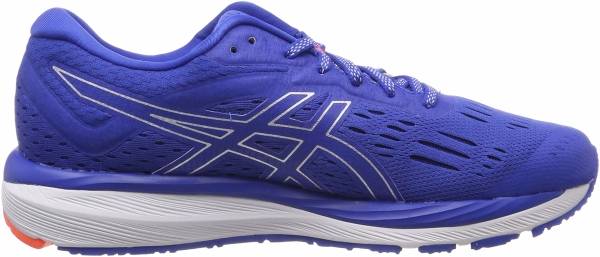Facts
| Update: | Asics Gel Cumulus 21 |
|---|---|
| Terrain: | Road |
| Arch support: | Neutral |
| Use: | Jogging |
| Weight: | Men: 285g | Women: 236g |
| Heel to toe drop: | Men: 10mm | Women: 10mm |
| Pronation: | Neutral Pronation |
| Arch type: | High arch |
| Strike Pattern: | Heel strike |
| Distance: | Daily running | Long distance | Marathon |
| Heel height: | Men: 23mm | Women: 22mm |
| Forefoot height: | Men: 13mm | Women: 12mm |
| Release date: | Jun 2018 |
| Brand: | Asics |
| Width: | Men: Narrow, Normal, Wide, X-Wide | Women: Narrow, Normal, Wide |
| Price: | €150 |
| Colorways: | Blue, Black, Grey, Pink, Red, Yellow, Green |
| Special editions: | 1 special editions |
Rankings
Expert Reviews
Experts are runners, who post reviews at youtube, directly at RunRepeat or at their own websites. Each expert is categorized from level 1 to level 5 based on expertise. See stats on expert reviews and how we calculate scores here.
Are you an expert? Apply to contribute here.
89 / 100 based on 16 expert reviews
-
Asics Gel-Cumulus 20 - Snappy happiness
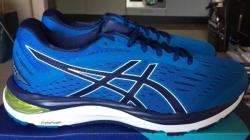
 More photos
More photos
Other than the Gel-Kayano series and the now discontinued GT 21XX (replaced by GT 2000), which are both support models, prior to Gel-Cumulus 20 I had never run in neutral shoes from Asics. I have since had the chance to test and review Gel-Nimbus 21, which is regarded the more plush sibling of Gel-Cumulus 20, and my initial thoughts on that shoe are here.
This meant that, for Gel-Cumulus 20, I was able to go into it with a completely open mind, with no preconceptions, expectations, or any hangovers from previous iterations of the shoe. The shoe for me is by and large a success, with great ground feel and snappiness.
The only let downs are the somewhat narrow fit and a touch too much structure in the rearfoot area, including the heel. Overall, a great shoe for faster-paced training sessions and for racing 10kms or half to full marathons.
First impression
Out of the box and in the hands, the shoes have a sleek, streamlined look to them. They are not the lightest of shoes, rated at 285 grams for Men’s, but lighter than Gel-Nimbus 21 (310 grams) or Gel-Kayano 25 (336 grams).

Much of the lightness is probably due to slightly thinner cushioning, but the shoe width and choice of upper material likely contributed as well. With stack height of 13mm in front and 23mm in back, the shoe comes with 10mm drop, which is within the 6-10mm range typical of medium to high mileage trainers.
As with the latest iterations of Gel-Kayano and Gel-Nimbus, Gel-Cumulus 20 employs two types of EVA foam; FlyteFoam Lyte on the bottom (the white layer in photo) and FlyteFoam Propel on the top (the blue layer). The idea is that the Lyte provides the cushioning while the stiffer, higher rebound Propel provides the bounce and drive through the gait cycle.
The trademark Asics Gel is also visible in the rear on the lateral side. I in fact found the configuration of FlyteFoam and Gel around the rearfoot area quite intriguing.
As can be seen in the photo showing the heel area, the medial side is built to offer quite a bit of cushioning via FlyteFoam Lyte. In my opinion, this makes Gel-Cumulus 20, despite being rated a neutral shoe, quite well-suited for moderate over-pronators as well.

Website blurb describes the outsole as “new full-ground contact.” I’m not entirely sure what this means since the outsole doesn’t look a whole lot different from other road shoes from Asics and others, with Asics Hard Abrasion Rubber (AHAR) in the heels and softer blown-rubber in the rest of the outsole.
Also visible in the outsole is the classic Guidance Line to aid a smooth heel-toe transition.
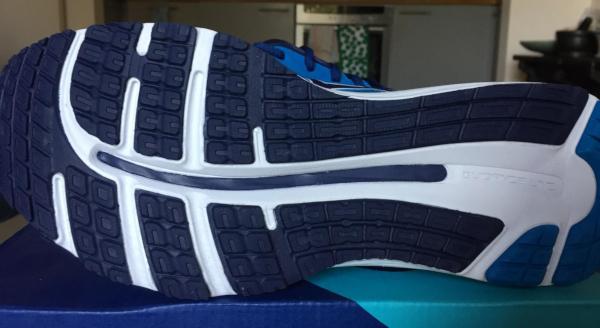
Fit/sizing
This is where I struggled. Normally a EUR 44.5 (which generally translates to US 10.5 or UK 9.5/10.0), I wear a size US 10.5 in other Asics shoes including Gel-Kayano 25 and Gel-Nimbus 21.
The same size in Gel-Cumulus 20, however, felt a half size too small, both in width and length. This was a bit of a surprise since the website states that the “new SpEVA Foam lasting provides ample room in the ball girth and toe area.”
Adding to the sense of constriction is the heavily structured heel – or rather – the entire shoe to the rear of the midfoot. The heel area just felt “over-built” and as result the shoe was very stiff. Probably the stiffest road shoe I had ever run in. As it turns out this stiffness is what translates to a feeling of “snappiness” once on the road, but the sensation was disconcerting nonetheless.

A closer inspection suggests the use of a rigid plastic heel cup which basically extends forward into the midfoot to provide that stiffness. This insert is quite substantial and makes up both the heel cup and the side wall of the entire rear half of the shoe.
While my first instinct was to think of this stiffness as a “bad” thing, I was then reminded of Nike’s use of carbon plate inserts in their ultra-premium Vaporfly 4%. Effectively stiffness = energy return, however, that stiffness is achieved.

As mentioned, the shoe fits very snug. This is somewhat ameliorated however by the upper construction, which contains many “slits” that ostensibly expand to help with a more precise fitting. I found this to be a great feature and without these, the shoes could have been too tight fitting to manage a run in.
Still, I found myself having to don my thinnest socks to pair up with Gel-Cumulus 20, even after more than 150 miles.
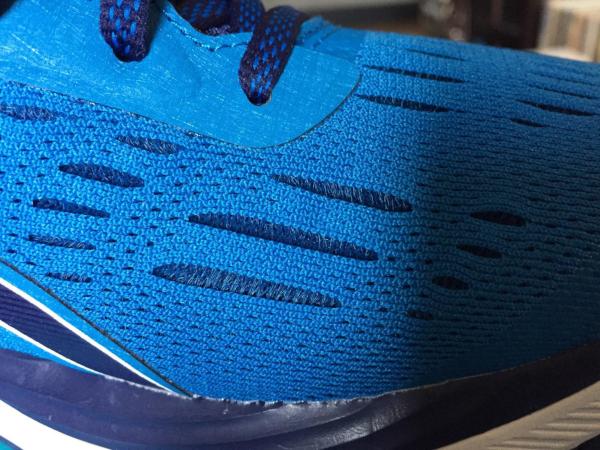
One other final comment regarding the upper and the shoe construction, in general, is that, for someone spoiled with Gel-Kayano 25 and Gel-Nimbus 21, which are Asics’ premium support and neutral cushioned shoes respectively, I found the manufacture of Gel-Cumulus 20 to be fairly utilitarian in comparison.
Gel-Cumulus 20 are noticeably less plush and with “rougher” edges so to speak in terms of finish. But – as mentioned – I have been spoiled!
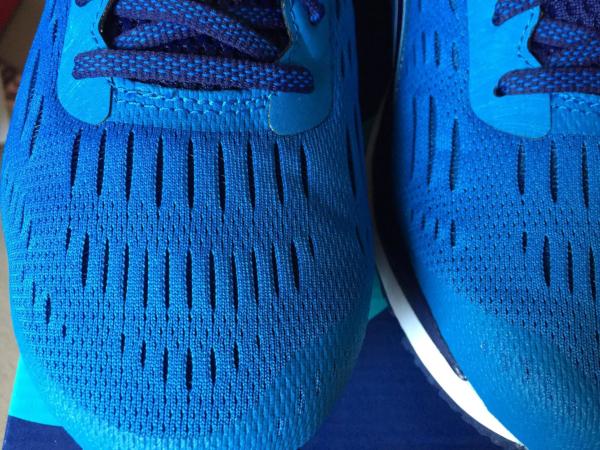
Road test
As is the case with all running shoes, observations and discussions regarding the design, materials, and construction notwithstanding, the real proof is in the pudding, or in this case, the road test.
And it is on the road that Gel-Cumulus 20 really shine. The balance of cushioning and responsiveness (read = road feel) is spot on, and the shoes feel peppy and full of bounce.
I attribute much of the peppiness to the stiffness of the shoes and the energy return that the rigid construction provides. As mentioned in the description there is a rigid plastic insert which extends from the midfoot all the way into the heel cup and it is this feature which I believe accounts for much of the “snappiness” of the shoe.
Despite the stiff nature of the shoe my heels stayed locked in, which was a pleasant surprise but then again may just be down to the aforementioned snug fitting.
The ride was consistent, whether landing on the midfoot or the heel and the transition smooth.
The peppiness, snappiness, from the shoe meant that these were well-suited to faster training sessions such as speed intervals and for racing anything from 10kms to half marathons and marathons. I haven’t used them to run a marathon in yet (and would probably hesitate to, given the snug fitting), but have used them successfully for racing a 10km and a half marathon, both to within minutes of my PB times.
Likes
- Smooth, expensive upper
- Snappy feel
- Good balance of cushioning vs. responsiveness
- Fast feel
Dislikes
- Rigid construction
- Slightly too snug
- Rough manufacturing finish
Summary
Despite some initial disappointment with lack of plushness and some misgivings regarding its stiffness, the shoes were a pleasant surprise in the way they performed on the road. The cushioning is not too soft or too much, and the ride is consistent irrespective of landing on the heel or elsewhere.
With a pronounced snappiness thanks to their rigid construction, the shoes are ideally suited for the more intensive, higher speed training sessions and for racing 10kms to half marathons in.
My only real caveat is with sizing. Gel-Cumulus 20 seem to come up slightly narrower and shorter than other Asics models I’ve tried and I would be tempted to size up by half.
This expert has been verified by RunRepeat. Reviews are neutral, unbiased and based on extensive testing.
-
Asics Gel-Cumulus 20 – A reliable all-rounder
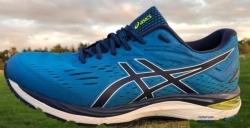
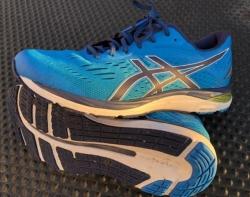 More photos
More photos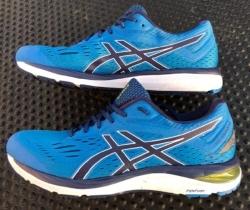
The ASICS Gel-Cumulus 20 is a solid, daily shoe that’ll go on and on, supporting and cushioning every stride as you churn out the miles.
Whilst remaining a neutral shoe, the Gel-Cumulus 20 provides plenty of security. The stiff, extensive heel cup holds the foot firmly yet comfortably, and there is additional arch support provided by the sock liner.
A combination of foam and gel technologies in the midsole offer good shock absorption and cushioning although this does come at the expense of responsiveness.
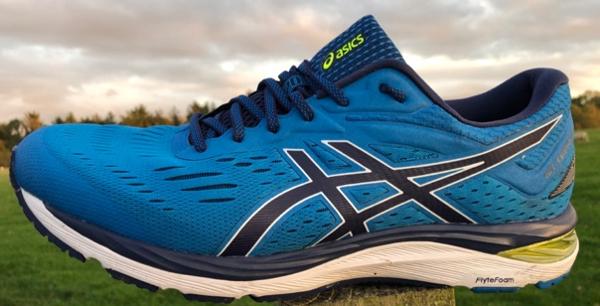
Pros
- Good Cushioning
- Supportive, Secure Fit
- Durability
- Roomy toe box
Cons
- Lack of Responsiveness
- Some may find the shoe restrictive
Introduction
It had been a very long time since I’d worn an ASICS road shoe, and so when I had the opportunity to test the Gel-Cumulus 20, I was very keen to see how it compared to the New Balance and Brooks road shoes I’ve used primarily in recent years.

First Impressions
The Gel-Cumulus 20 looks and feels like a solid, well-built shoe. Initial impression is that it is of similar build quality to the New Balance 1080v8 or the Brooks Ghost 11.
When I lift it from the box, however, the upper feels far stiffer and more supportive than either of these other shoes, in particular, the extensive heel cup which is high, solid and extends a long way forward, almost in line with the laces. There also seems to be much more arch support though a little investigation reveals that this is in large part due to the sock-liner which extends up into the arch.
The shoe comes in a range of colours. Men’s shoes are primarily in blues and greys though there is a bright red for anyone wishing to make a statement. The ladies shoes have largely similar base colours but are generally highlighted with brighter colours, as well as a Mojave / Fuschia Purple. My shoe pictured here is the Race Blue / Peacoat.
Weight
The Gel-Cumulus 20 is listed at 285g (10oz) which means that it is not a light shoe, but it is pretty well where you’d expect the weight to be for an everyday shoe with the level of cushioning provided. It also weighs in lighter than the Ghost 11 (309g) and the 1080v8 (314g).
As expected, my UK 13 (US14) weighed in heavier than the standard shoe, at 360g, and whilst it obviously isn’t a light shoe, it did not feel significantly heavy when running.

Fit
I have previously tended to wear ASICS “true to size” so that I’ll wear a UK 13 / US 14. This is the same as I’d wear in Brooks and Inov-8 compared to New Balance, Hoka, and Salomon Trail where I’d size up by ½ (UK).
US readers please note that despite the variation in sizing across manufacturers, I almost always require a US 14 / EU 49. It’s quite possible that the differences in sizes, therefore, are due to conversions from US to UK sizing.
The Gel-Cumulus 20 is a fairly snug fit. It is narrower than the road shoes I’d usually wear (more akin to an Inov-8 precision fit), throughout the length of the shoe, although there is more space in the toe box.
ASICS do offer this shoe in a wide fitting which I’d recommend for any runner with feet even slightly wider than usual. Furthermore, if I had this shoe again, I would probably go up by ½ size to provide a little more room.

I had expected the extensive, stiff heel cup to feel somewhat confining, but was pleasantly surprised to find that whilst the foot was held snugly, it was also comfortable throughout all of my runs and did not impinge on my running style or ankle movement at all.
Construction
Upper
The construction of the upper is similar to many similar shoes across the industry; a double layer of engineered mesh, with fine holes and slits in the outer layer to allow movement and ensure that the shoe is breathable.
Overlays are glued to the mesh in the shape of the ASICS logo to provide additional support to the midfoot, and also to form the lace eyelets. The placement of these overlays is effective, and when laced, the foot feels secure and well-held throughout.
The “toe bumper” appears to be a simple reinforcement of the mesh around the front of the shoe, perhaps using a form of resin, which means that the toe is offered a degree of protection without sacrificing either flexibility or weight.

The tongue is well-cushioned, simply stitched at the bottom, and held in place by a lace-loop in line with the third row of holes. The tongue is comfortable and held well by the flat laces. Once laced in, I’ve never felt the tongue move at all.

The shoe does not appear to be exceptionally well cushioned around the ankle, especially when compared to a Ghost 11 or similar shoe, but nor does it need to be.
The ankle and heel feel more than comfortable enough, and as mentioned above, there is no intrusion from the high, stiff hell cup; the shoe simply holds the foot in place comfortably.
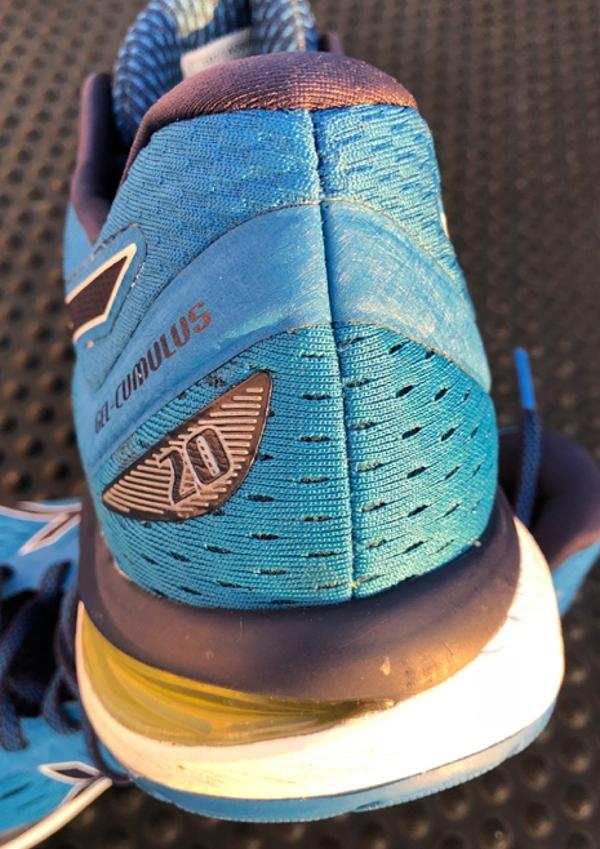
Midsole
As someone who hasn’t worn ASICS road shoes for a while, this is the bit that took a little bit of getting my head around due to the different compounds used in the sole, and the company’s own description only added to the confusion with the Gel-Cumulus 20 “…featuring new FlyteFoam technology for optimal bounce back, new full-ground contact outsole for smoother heel-to-toe movement, and a new SpEVA Foam lasting that provides ample room in the ball girth and toe area… and GEL technology cushioning system ensure enduring comfort”.
So, my understanding is that the upper is stitched to a Strobel board of Asics’ SpEVA foam (light blue, and visible below the sock-liner) which is glued to the layer of Flytefoam Propel (the dark blue layer seen on the images) which is softer, and gives greater energy return and propulsion in the toe-off than the standard Flytefoam (the white layer) on which it sits, and which provides the cushioning and stability.
Sandwiched between these layers of Flytefoam below the outside of the heel is ASICS unique gel system which reduces the impact of the heel on landing. Above all of this sits a well-cushioned sock-liner which partially extends up into the arch of the foot to enhance support.
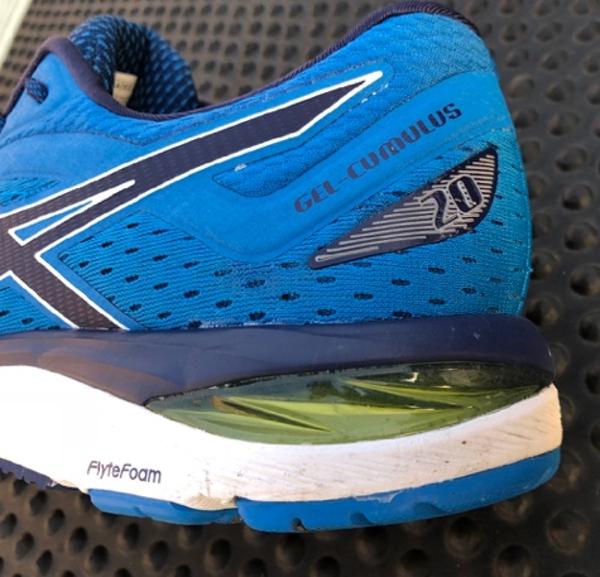
Whether or not you followed all that, the most important question is, of course, how does it feel? Perhaps surprisingly, the variety of compounds and materials that make up the insole of the Cumulus 20 actually seem to work well together to provide a comfortable low-impact landing, smooth transition and decent toe-off.
The Gel-cumulus 20 provides a 10mm heel drop comprised of a 23mm heel and 13mm forefoot (men's).
Outsole
The Gel-Cumulus 20 outsole employs Durasponge blown rubber sections surrounding ASICS’ vertical groove in the sole to “guide the foot through the gait cycle”, together with ASICS High Abrasion Rubber (AHAR) in the areas of high wear at the heel (light blue on this shoe).
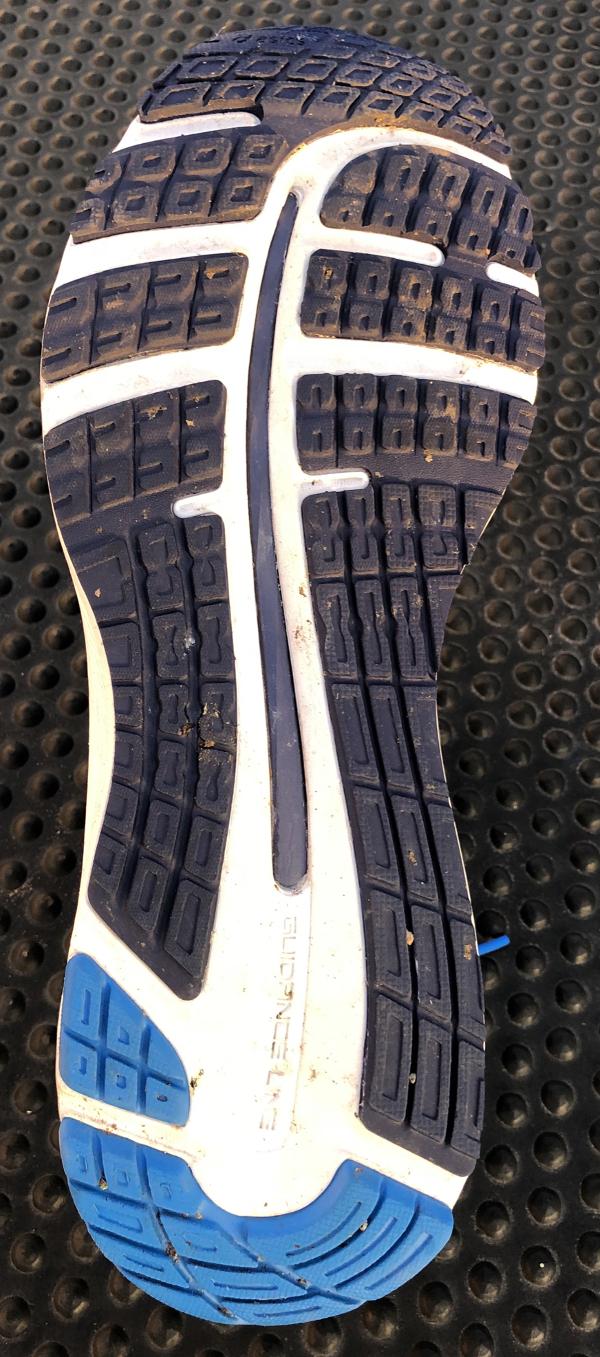
The Durasponge is lighter and more flexible than the AHAR. As the outsole is constructed in sections, with foam exposed in places, this should also deliver a more flexible shoe.
In reality, the outsole cannot overcome the stiffness of the Flytefoam, and so the shoe doesn’t quite have the flexibility that the segmentation of the outsole suggests.
Durability
At the time of writing, I’ve run around 50 miles or so in these shoes. I’ve mixed in a couple of longer runs together with some mid-paced training runs and a couple of shorter, faster sessions.
So far, neither the upper nor the outsole of the shoes shows barely any sign of wear. Given the quality of construction of the shoe and the materials used, I would be very surprised if the shoes did not provide most runners with at least 500 miles of runners.
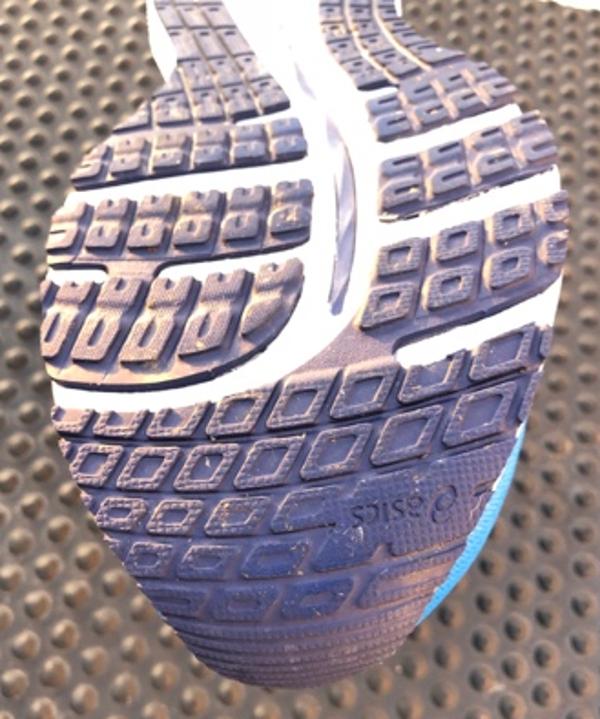
Performance
Running shoes are highly personal, and so my experience and views of a shoe’s performance are based on my own experience and characteristics. I can’t speak for the front of pack runner but hope my views will be useful for both club runners and newer runners, as well as those on the heavier side (I’m around 85kg).
The first few runs in this shoe were at a fairly steady pace; nice easy run, which if I’m honest didn’t do too much to tax either myself or the shoe. I’d recently come off the back of a few high mileage months culminating in a PB marathon attempt followed a few weeks later by my first ultra.
The Gel-Cumulus 20 was perfect for this type of running. The confusing combination of foam and gel in the heel provided greater cushioning than I’ve felt in other shoes that I’ve used for this type of run e.g. Ghost 11, 1080v8. The gel seemed to absorb the impact of the heel strike in a way that makes it ideal for those recovery days when the legs need a little tlc.
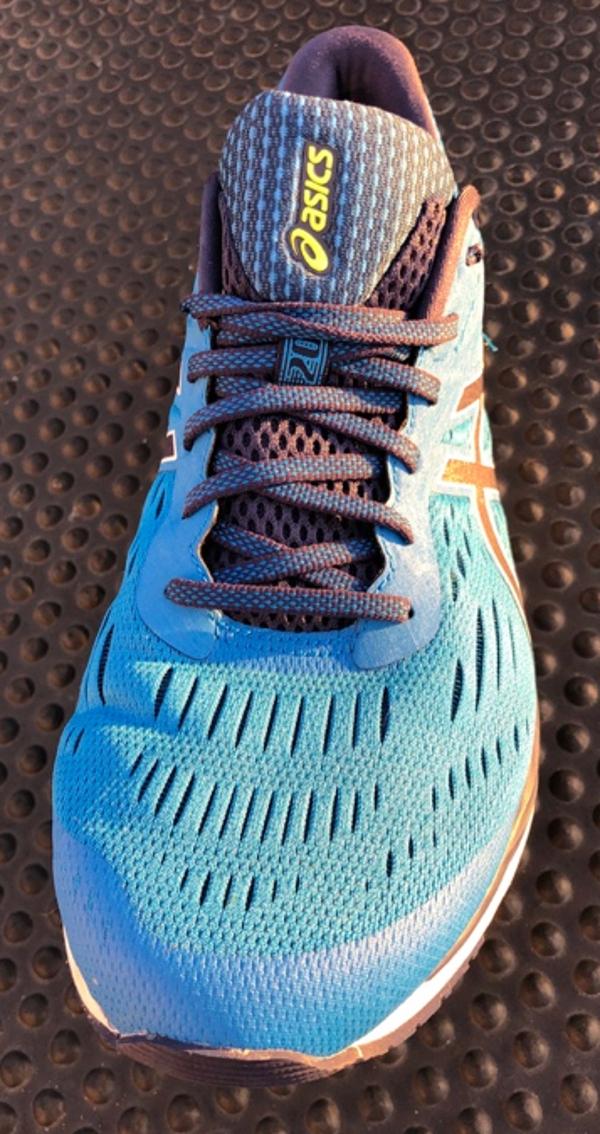
Unfortunately, the superior cushioning and absorption meant that there is very little energy return from the midsole, and I found it took more effort to increase the speed closer to marathon pace.
I'm pretty well decided that the shoe should be resigned to those easy recovery runs, or long slow sessions, but wasn’t ready to write it off until I’d at least tried a couple of faster pieces.
Once the legs had recovered a little, I pulled on the shoes for the first interval session of my new cycle of training – (10 x 500m with 500m easy recovery). I was really surprised to find the shoe to be very responsive in the intervals which were done at just faster than 5k pace.
As I landed further forward on the foot, I found that the foot was well cushioned with each strike, but that at this faster pace, there was a fast transition and return of energy. I’ve found the same to be the case in subsequent interval sessions.

So, this is almost two shoes in one. The heel-striker will find a well-cushioned trainer for long or steady recovery runs. Increase the pace and move the landing forward to the mid or forefoot and you’ll find a responsive shoe for faster intervals.
I did, however, say that it is almost two shoes in one. Unfortunately, the weight of the shoe and lack of flexibility in the heavily built heel and midfoot make it unlikely to be the first choice for fast-paced training sessions or race-day.
Summary
The Gel Cumulus v20 is a reliable all-around daily shoe. It’ll hold the foot well whilst allowing sufficient movement, and I’m confident that it is durable enough to outlast many other shoes. It’s a great choice for those easy paced days, or for running longer distances during which it will offer excellent cushioning with each strike.
The responsiveness of the shoe at faster paces means that it could be a good choice as “one-size-fits-all” shoe for someone fairly new to running as it will be at home on a variety of surfaces including light trail. If you’re looking for that type of shoe, I’d also recommend considering the Brooks Ghost 11.
This expert has been verified by RunRepeat. Reviews are neutral, unbiased and based on extensive testing.
-
It's been a fan favorite for over [sic] 20 years and there's lots of reasons why, and even more reasons now: It's super responsive, super cushioned, and its lighter weight -- you will love this shoe.
-
If you're just looking for a new shoe to try, [this is a] great moderate-cushioned shoe. The only thing is if you're a smaller human being, this may be a little bit too much of a shoe for you.
- Asics has released the 20th-anniversary version of the Gel Cumulus, and in this iteration, updates are presented through new materials that deliver an equally new fit-and-feel. While the shoe maintains a standard-weight structure and the familiar silhouette of the Gel Cumulus, this edition claims a more robust platform and a softer cushioning compared to previous releases.
- The upper displays a broader and higher toe box than the one in Gel Cumulus 19. The overall fit aims to be more snug and secure, as the heel cup and the ankle collar are now firmer. While the Gel Cumulus 20 retains the Discrete Eyelet™ in its lacing system, a new structure present is the reflective strip in the heel area.
- The midsole of the Gel Cumulus 20 has kept most of the technologies of the previous version. The only noticeable changes are the addition of a new cushioning compound and an updated sock liner. Meanwhile, the outsole brings back the DuraSponge® component which was included in the 18th iteration but not in the 19th.
The Asics Gel Cumulus 20 features standard running shoe length, sizing, and weight. The shoe runs true-to-size, and accommodates wearers of all foot volumes, thanks to the width options of medium and wide for both the men’s and women’s versions.
The Gel Cumulus 20 combines two distinct types of resources for its outsole – the Asics High Abrasion Rubber (AHAR®) and the DuraSponge®. Both materials work together to give the foot full ground contact and a stable ride.
First, the AHAR® compound is found on the shoe’s critical, high-wear areas. Asics also used the material in the Kayano 25. With its abrasion-resistant quality, the shoe levels up on durability while maintaining the capacity for traction. It uses the same rubber that forms car tires; thus, runners are sure of its toughness.
Next, the DuraSponge® rubber makes up the rest of the outsole. While it is also resistant to damage, this compound is made of blown rubber, making it a little bit softer than AHAR®. This permits the underfoot a comfortable ride and qualifies a flexible stride.
The most notable update in the Gel Cumulus 20 is the utilization of FlyteFoam® technology in the midsole. This system aims to provide a consistent level of reaction, even for long distances. The Flytefoam® method uses unique organic fibers to form a cushioning that is 55% more lightweight than traditional midsoles. Aside from responsiveness, Flytefoam® also guarantees a flexible and resilient fit all throughout the run. These qualities help in making the Gel Cumulus 20 a durable shoe.
The main midsole component of this neutral shoe is the FluidRide®, which is the combination of Solyte™ and SpEVA™, both cushioning compounds exclusive to the brand. FluidRide® is lightweight yet sturdy, and it helps improve running performance through its shock-absorbing and high-rebound properties.
Like all other Gel shoes, the Gel® cushioning system makes its way into the forefoot and rearfoot areas of this shoe. The Gel® zones act as shock absorbers through the gait cycle. As smooth transitions are achieved, the foot is enabled movement in different planes.
The Gel Cumulus 20 also employs the IGS®, short for the Impact Guidance System. IGS® is the term for the design of the shoe that aims for dynamic and adaptive stability. IGS® uses the Guidance Line® as a tool to help achieve the goal. With Guidance Line®, the center of pressure is adjusted, thus improving balance and gait efficiency.
An OrthoLite® sock liner supplies additional cushioning and underfoot protection. It has an antimicrobial property that promotes a healthy foot environment.
The stretchable Jacquard mesh upper gives the Gel Cumulus 20 a flexible, customized fit. Its elasticity is multidirectional, which brings freedom of movement. The mesh is reinforced in strategic areas to lend the shoe a supportive framework. With seamless construction, the shoe has fewer chances of causing skin irritation.
A Discrete Eyelet™ feature is present in the lacing system of the shoe. These are independent holes that target a custom-fit and enhanced comfort, as they reduce the tension that is caused by tightened shoelaces going through a single eyelet.
The upper, just like the GT 1000 7, also possesses a reflective strip in the heel area to allow prominence in low-light conditions.







